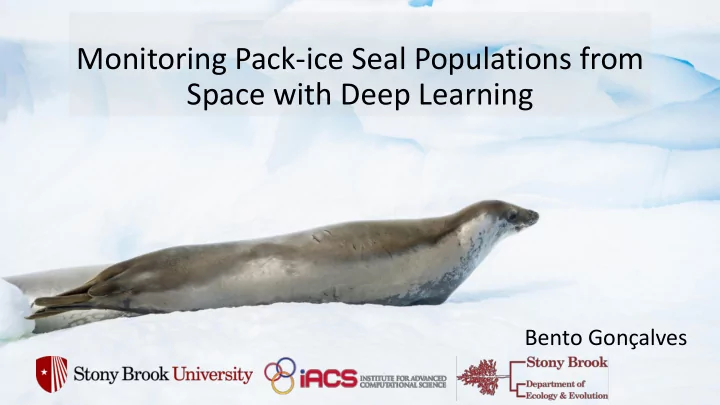

Monitoring Pack-ice Seal Populations from Space with Deep Learning Bento Gonçalves
Outline Introduction • Antarctic Ecology 101 • Intro to computer vision • Seal detection pipeline Present work • Training set • Haul out detection CNNs • Counting CNNs Summary and next steps Big Picture: How many pack-ice seals are in Antarctica? 1/20
Introduction
Antarctic Ecology 101 2/20
Antarctic Ecology 101 2/20
Antarctic Ecology 101 2/20
Intro to computer vision • Artificial neural networks – Deep learning • Convolutional neural networks Output (CNN) Input image • Data hungry • Computationally expensive Convolutions Subsampling Convolutions Subsampling 3/20
Intro to computer vision • Artificial neural networks – Deep learning • Convolutional neural networks (CNN) • Data hungry • Computationally expensive • CNN Architectures: • VGG16 • Resnet • Inception 3/20
High-resolution satellite imagery • WorldView-3 • 31cm resolution at nadir • Coverage is not as good as low-res sensors (e.g. MODIS) • Scene (~ 300 km 2 ) vs. Patch (1 ha) 4/20
Model framework – pipeline STEP 1: Buffer out scenes that are too far from the coastline or with too much cloud cover, split remaining scenes into patches 5/20
Model framework – pipeline STEP 2: Extract STEP 1: Buffer out environmental data at scenes that are too far input locations from the coastline or with too much cloud cover, split remaining scenes into patches 5/20
Model framework – pipeline STEP 2: Extract STEP 1: Buffer out STEP 3: Sweep environmental data at scenes that are too far through patches with input locations from the coastline or a classification CNN with too much cloud trained on groups of cover, split remaining seals scenes into patches 5/20
Model framework – pipeline STEP 2: Extract STEP 1: Buffer out STEP 3: Sweep STEP 4: Locate and environmental data at scenes that are too far through patches with count individual seals input locations from the coastline or a classification CNN inside flagged patches with too much cloud trained on groups of with a detection CNN cover, split remaining seals scenes into patches 5/20
Groups of seals – crabeaters 6/20
Single seals 6/20
BONUS: emperor penguins 7/20
BONUS: emperor penguins 7/20
Present work
Training set creation • Patch extraction • ~78000 labeled patches across >30 scenes • 11 training classes • Context information: • Broad spatial context • Environmental covariates 8/20
9/20
Multiscale training set • Spatial pyramid • Provide broad spatial context • Broad context bands down-sampled to patch size 10/20
Multiscale training set • Spatial pyramid • Provide broad spatial context • Broad context bands down-sampled to patch size 10/20
Multiscale training set • Spatial pyramid • Provide broad spatial context • Broad context bands down-sampled to patch size 10/20
Data augmentation scheme • Random crops • Random rotations • Mirroring • Contrast • Brightness 11/20
Positive classes Emperor penguin – 7105 patches Weddell seal – 981 patches Crabeater seal – 4174 patches Marching-emperor – 1060 patches 12/20
Hard negatives • 7 classes, including open water, pack ice (without seals), etc. 13/20
Haul out detection CNNs Model architectures: • Resnet18, Densenet169, etc.. (already implemented with PyTorch) • NASNet (Zoph et al 2017) Training setup • Adam optimizer with learning rate 0.001 and 0.95 learning rate decay per epoch • Trained from scratch with cross-entropy loss arXiv:1707.07012 [cs.CV] 14/20
Validation • Best performing architecture is task dependent • Precision: TP / (TP + FP) • Recall: TP / (TP + FN) model architecture 14/20
Solutions for counting small objects Regression CNN • Maps image to a real number • Training objective: match ground- truth count (minimize mean-squared error) Object detection CNN • Detects individual seals in an image • Training objective: match the position of predicted seals and ground-truth location (minimize Euclidean distance) 15/20
Regression CNNs Model architectures • CountCeption (Cohen et al 2017) • WideResnet • Modified classification CNNs Subitizing arXiv:1703.08710 [cs.CV] 16/20
Regression CNNs Model architectures • CountCeption (Cohen et al 2017) • WideResnet • Modified classification CNNs Subitizing Validation results model architecture arXiv:1703.08710 [cs.CV] 16/20
Pipeline output Class crabeater rock Pack-ice Count 17/20
2018 onwards
Hyperparameter search • The usual… (learning rate, decay, batch size, etc.) • Input image size (training set and model) • Augmentation scheme • Number (and dimensions) of multi-scale bands (multiscale training set) • Model architectures 18/20
Training a CNN: an iterative process Get results Train model Think Update model / training set 19/20
Summary • Promising approach for pan-Antarctic pack-ice seal survey • 2018 onwards: 1. Larger training set (2017-18 imagery not yet incorporated) 2. Apply pan-sharpening to panchromatic imagery training set 3. Leverage environmental covariates and a priori knowledge about pack-ice seal biology 4. Include broad spatial context for input patches 5. Get better ground-truth for seal counts / locations 20/20
Summary • Promising approach for pan-Antarctic pack-ice seal survey • 2018 onwards: 1. Larger training set (2017-18 imagery not yet incorporated) 2. Apply pan-sharpening to panchromatic imagery training set 3. Leverage environmental covariates and a priori knowledge about pack-ice seal biology 4. Include broad spatial context for input patches 5. Get better ground-truth for seal counts / locations Computational resources significant – requires substantial investment in HPC cyberinfrastructure for imagery 20/20
Acknowledgements
ICEBERG - Imagery Cyberinfrastructure and Extensible Building-Blocks to Enhance Research in the Geosciences • One piece in the bigger picture • Empowering polar sciences with HPC • Bridges supercomputer
Confusion matrices (Haulout CNNs) Densenet 169 NASnet
Recommend
More recommend